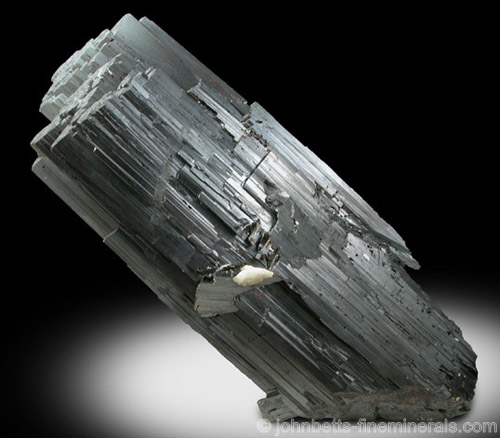The Mineral ferberite

Ferberite is the iron-rich end member of the Wolframite series. It is not always individually
distinguished and is sometimes just classified as
Wolframite. The presence of iron in its structure is responsible for its black color and opacity in relation to Huebnerite. Ferberite is named after German mineralogist Dr. Moritz Rudolph Ferber (1805-1875).
Crystal System
Monoclinic
Crystal Habits
Most often in long prismatic crystals, columnar groups, blocky
and chisel-shaped crystals, and flattened tabular crystals. Also in
dense bladed clusters and rosettes, reticulated,
acicular, grainy, in veins, encrusting, and massive.
Crystals are often striated lengthwise, and may be twinned as
repeated twins with a v-shaped notch in the center. May also form as a pseudomorph after Scheelite assuming a pseudo-octahedral shape.
Uses
Ferberite is an important ore of tungsten. Good specimens are not common, and are highly desired by mineral collectors.
Noteworthy Localities
One of the most spectacular occurrences of Ferberite is the famous tungsten mine of Panasqueira, Covilhã, Castelo
Branco District, Portugal. This locality is especially known for it large and thick Ferberite crystals of excellent quality. An old classic European locality is Zinnwald, Saxony, Germany (and Cínovec, Bohemia, Czech Republic, which is right across the border in the same deposit). Beautiful crystal clusters and sprays of Ferberite came from Baia Sprie (Felsöbánya), Maramures, Romania.
Some of the best Ferberite crystals, both in size and quality, are the well-terminated and heavily striated crystals from the Yaogangxian Mine, Hunan Province, China. Sharp black crystals came from Tae Hwa Mine, Chungju, Chungcheongbuk-do, South Korea. Another important Asian locality is Kara-Oba, Karagandy Province, Kazakhstan.
In the Western Hemisphere, highly lustrous and often twinned Ferberite crystals are found in the Tazna Mine, Atocha, Potosí Department, Bolivia. The U.S. has several sporadic occurrences, especially in Colorado, with the best being Nederland, Boulder Co., Colorado, where it occurs in bladed and platy crystal groups. Excellent pseudo-octahedral pseudomorhs after Scheelite were once found in Trumbull, Fairfield Co., Connecticut.
Distingushing Similar Minerals
Ferberite - Has a lighter color, more transparent, slightly lighter in weight.
Rutile - Harder, crystals are usually thinner, and usually lighter gray in color.
Goethite - Has a lower specific gravity.
Columbite-Tantalite series - Different crystal form, cleavage less distinguishable.